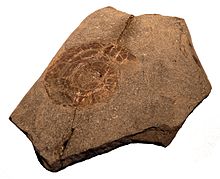Psiloceras
| Psiloceras Temporal range:
| |
|---|---|

| |
| Psiloceras planorbis | |
| Scientific classification | |
| Kingdom: | |
| Phylum: | |
| Class: | |
| Subclass: | |
| Family: | |
| Genus: | Psiloceras Hyatt, 1867
|
| Species[2] | |
| |
Psiloceras is an extinct genus of cephalopod belonging to the ammonite subclass. Psiloceras fossils are commonly found at Watchet, Somerset, England. Here smooth-shelled Psiloceras planorbis (along with other species) are to be found as usually flattened fossils in the Blue Lias.[3] Unlike most earlier ammonites, which had complex shell shapes and ornamentation, Psiloceras had a smooth shell.[4][5]
Taxonomy
All Ammonites, with the sole exemption of the genus Psiloceras were wiped out at the Triassic–Jurassic extinction event (201.3 million years ago). Hence all ammonites that lived during the Jurassic and Cretaceous are descendants of Psiloceras.[4]
Most authors assume that Psiloceras descended from the Phyllocerataceae. P. spelae is probably the earliest species of Psiloceras.[6][7]
Biostratigraphic significance
The International Commission on Stratigraphy (ICS) has assigned the First Appearance Datum of the Psiloceras spela-group as the defining biological marker for the start of the Hettangian, 201.3 ± 0.2 million years ago, the earliest stage Jurassic.
Distribution
Jurassic of Argentina, Austria, Canada, China, France, Germany, New Zealand, Spain, the United Kingdom, United States [2]
References
- ^ Sepkoski, Jack (2002). "Sepkoski's Online Genus Database". Retrieved 2014-05-28.
{{cite journal}}: Cite has empty unknown parameter:|coauthors=(help); Cite journal requires|journal=(help) - ^ a b Paleobiology Database - Psiloceras. 2014-05-29.
- ^ Davies, G. M. (1964). The Dorset Coast. London: Adam and Charles Black.
- ^ a b "Psiloceras pacificum". New Mexico Museum of Natural History and Science. Spring 2008. Archived from the original on 10 May 2015. Retrieved 5 August 2013.
- ^ Howarth, Michael K. (2013). "Chapter 4: Psiloceratoidea, Eodoceratoidea, Hildoceratoidea.". In Selden, Paul A. (ed.). Treatise Online, Part L (Revised) Mollusca 4, vol. 3B, Triassic and Jurassic Ammonoidea. Lawrence, Kansas: Paleontological Institute, University of Kansas,. doi:10.17161/to.v0i0.4441.
{{cite book}}: CS1 maint: extra punctuation (link) - ^ Hillebrandt, von, A. "Paleobiogeography and Relationship of South American Hettangian (Lower Jurassic) ammonites" (PDF). Institut für Angewandte Geowissenschaften II. Retrieved 4 August 2013.
- ^ Hillebrandt, von, A.; Krystyn, L. (2009). "On the oldest Jurassic ammonites of Europe (Northern Calcareous Alps, Austria) and their global significance" (PDF). N. Jb. Geol. Paläont. Abh. 253 (2–3): 163–195. Archived from the original (PDF) on 2013-12-09.
